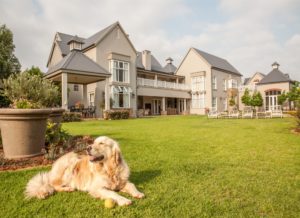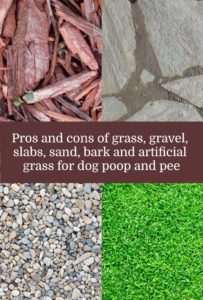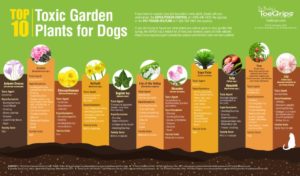How to Create a Safe, Pet-Friendly Backyard

You love your dogs like family, so it’s only natural to want to give them the very best. With modern technology that allows you to watch and talk to your pets while you’re at work, apps that bring trusted dog walkers to your front porch and premium dog food, treats and toys, the petcare industry is expected to reach a whopping $202.6 billion by 2025.
So it should come as no surprise that there’s an entire sector dedicated to turning your backyard into your dog’s dream space. I’m talking about a new trend called “petscaping” or “dogscaping,” in which your landscaping choices focus on creating a safe, pet-friendly environment.
While you can certainly pay someone to do this, if you enjoy landscaping it can also be a fun DIY family project. And if you’re still in the process of house hunting, these tips can help you spot a pet-friendly backyard as you’re touring houses.
Here are some key components to a safe, pet-friendly backyard.
1. Nontoxic Landscaping Chemicals
If you do nothing else to create a pet-friendly backyard, at least make sure the chemicals you or your landscaping company use are safe and nontoxic for your pets. While advances in the pesticide, herbicide and insecticide industries have been made to create safer alternatives, it’s up to pet owners to carefully research lawn chemicals and decide if the benefit outweighs the risk. Some safe alternatives are dish soap, diatomaceous earth, hot pepper spray, and/or neem oil are just a few of the great alternatives available according to Amber Guetebier and her article 11 Natural and Homemade Insecticides That Will Be Your Gardening Heroes.
How important is the perfect green lawn to you? Can you settle for a mediocre lawn or less turf and more natural and hardscaped areas if it means keeping your dog safe? These are important questions to ask yourself.
2. Designated Potty Spot
Dog urine kills grass. The exception is clover (and there’s plenty of research to show why clover lawns are beneficial). But if a clover lawn doesn’t appeal to you, you need to figure out a way to teach Fido to use a designated potty spot.
Wooded or mulched spots, crushed gravel or small pebbled areas are ideal as they will absorb urine and keep it away from plants. Some homeowners even opt for artificial turf in potty areas that instantly drains, is easy to clean with a hose and inhibits bacteria. There are pros and cons to all of these, but in the end it eventually depends on personal preference and budget.
No matter what you decide, the key is training your pups to use the dedicated space. The best way to keep your dog from going outside of the area you choose is to keep it on a leash. Take your dog on a leash to the spot you want to use and say the cue word. Keep the dog in that spot until it goes, then offer a reward. If they go potty in another part of the yard, immediately stop playtime and bring the pup indoors. Your dog will quickly learn that relieving itself in the right spot means it gets to play while going anywhere else brings playtime to an end.
3. Engaging Dog Run
Dogs are natural patrollers. They love to run along the fence, find high ground to observe from and navigate obstacles. Have you ever seen a backyard where the dogs have literally worn a path through the grass that marks their favorite route?
If you don’t want your dog creating their own run, build an engaging one for them. Instead of grass, which will eventually become a muddy mess, choose hardscapes, stone, gravel or mulch. Make the run interesting; don’t put it in an out-of-the-way spot on the side of the house. Your dog wants to be in the mix and see what’s going on — both inside and outside of its yard.

Go a step further and bury tunnels, making the run go over and under the tunnels to add interest. Got a dog that loves to dig? Let them! At some point on the run, build a sand digging pit and encourage your pup to dig there instead of under your fence.
4. Safe, Nontoxic Plants
According to Pet Poison Helpline, there are thousands of species of plants and flowers, but only a small percentage are truly dangerous and poisonous to your pet. It’s up to you as the pet owner to know which plants to avoid in your yard.
The helpline has compiled this list of the top 10 common toxic plants. A simple google search will a give you a complete list of plants and household items that are poisonous to pets. Save this number to your phone in case of accidental ingestion: 24/7 Animal Poison Control Center, (855) 764-7661. Whether you’re petscaping your own backyard or you’re shopping for a new house, be on the lookout for these toxic plants and remove them.
5. Protected Garden Areas
Ever look in your backyard after your dog has been out for a romp and say to yourself, “And this is why we can’t have nice things”? It’s a fact of life that dogs like to dig, chew, roll and otherwise explore and mark their territory. While training your dog (such as using the designated potty area) is a big part of keeping your yard in good shape, there are safe, natural deterrents that can also help protect your nicer garden areas.
- Raised beds, fences and other physical barriers
- Strategic planting of hardier plants on the perimeter and delicate plants in the interior
- Barriers or moats filled with prickly plant materials such as juniper, holly or pinecones
- Motion-activated sprinklers, lights or decoy predators
- Natural deterrents such as vinegar, hot sauce, coffee grounds or orange peels
6. Just Add Water

Access to clean, fresh water is critical for your pup when outside — especially in the summer. While a bowl under your outdoor spigot will certainly do the trick (as long as it’s clean and refilled), you might also choose to do a permanent water feature with your dog in mind. Dogs love playing in water, so a running fountain, bubbling brook or small pool will delight them to no end.
Doggy pool? Yes! There is even an entire market for dog pools. From rigid designs that are basically the same as a kiddie pool to inflatable and even foldable, it is possible to find a dog pool that fits your needs and budget — and of course one that fits your pup!
Petscape With Your Pup in Mind
A pet-friendly backyard is a win-win all around. Your dog can be a part of the action and maybe even get some special features all their own. And you can rest easy knowing your yard is as safe and comfortable for your pet as possible.


